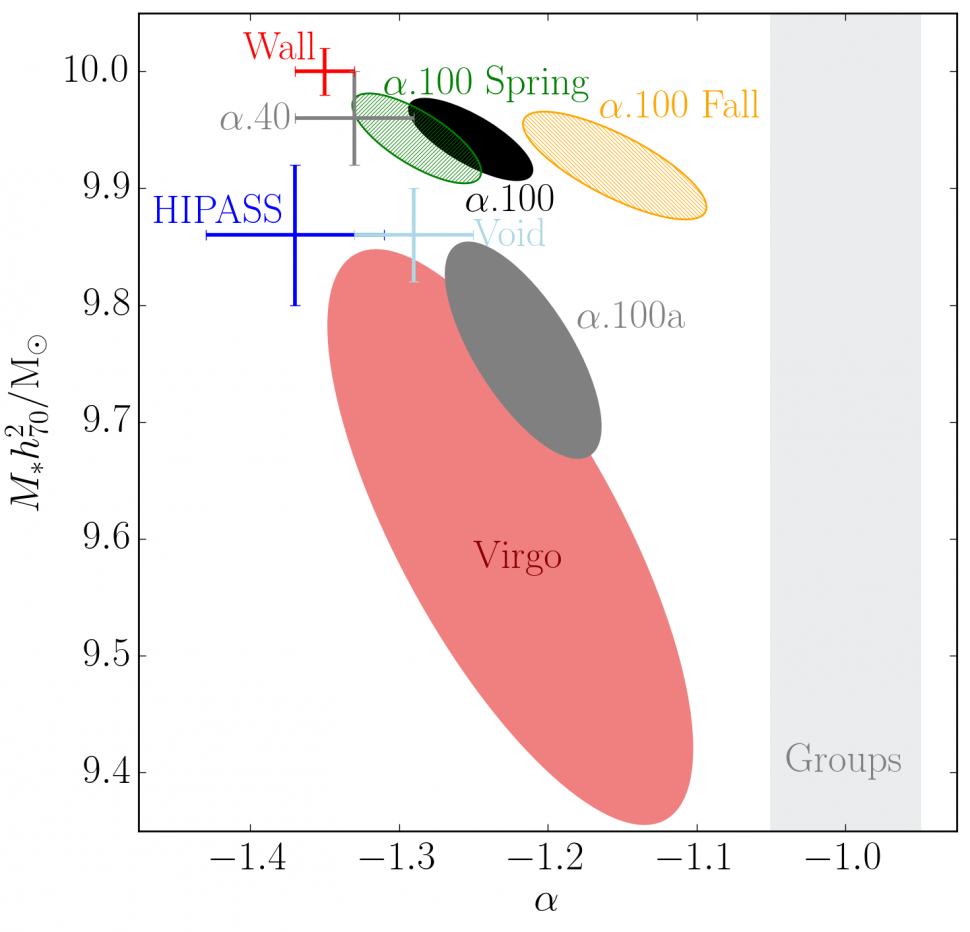ALFALFA HI Mass Functions (2018)
Scientific Results
- Positions for CIG galaxies
- Redshift and distances
- Morphologies
- Isolation
- A catalogue of neighbours around isolated galaxies based on POSS I & II images
- Quantification of isolation based on POSS I & II images
- Revision of isolation criteria using the SDSS
- Effects of the environment on galaxies in the..
- Catalogues of isolated galaxies, isolated pairs, and isolated triplets..
- Star formation
- Optical specialization
- Radio continuum properties
- Atomic gas
- Isolated Galaxies
- Environment and faint features of CIG 96: deep optical and HI observations (2018)
- Atomic gas scaling relations (2018)
- A ∼12 kpc HI extension and other HI asymmetries in the isolated galaxy CIG 340 (2014)
- HI asymmetry in the isolated galaxy CIG 85 (2012)
- HI asymmetries in the isolated galaxy CIG 292 (2011)
- Asymmetries in isolated galaxies (2011)
- The large asymmetric HI envelope of CIG 96 (2005)
- Compact groups
- Studies of complementary samples
- Isolated Galaxies
- Molecular gas
- Nuclear activity
ALFALFA HI Mass Function
The Arecibo Legacy Fast ALFA (Arecibo L-band Feed Array) survey, or ALFALFA, is a blind HI survey that has detected over 30,000 HI-bearing galaxies across approximately 1/6th of the sky. Unlike AMIGA this is not a targeted sample so it represents an unbiased accounting of the HI galaxy population, rather than one that specifically targets only the most isolated galaxies. However, as ALFALFA requires a galaxy to contain HI in order for it to be detectable, these galaxies are generally field objects, not those in clusters which are usually devoid of neutral gas, and thus ALFALFA represents an intermediate sample with which AMIGA can be compared.
The HI mass function (HIMF) is the intrinsic distribution of galaxy HI masses in the Universe, this is analogous to the distribution of weights of all the people on Earth. As ALFALFA is a blind sampling of the HI population it is ideally suited to calculating the HIMF and is the largest HI-selected sample available to date. While the distribution of human weights would likely follow a normal distribution, the distribution of galaxy HI masses has been shown numerous times to follow a Schechter function form: a power law increasing towards lower masses, and a transition to exponential decline towards higher masses, occurring at the “knee” mass.
The measured value of the low-mass slope in the 100% ALFALFA catalogue is considerably flatter than the preliminary findings from the 40% release. This is because the ALFALFA survey footprint is split into two separate regions called the Arecibo Spring sky (towards 12 hr RA) and Fall sky (towards 0 hr RA). The 40% catalogue mainly contained coverage from the Spring sky and we find a marked dichotomy with the low-mass slope being around 0.15 flatter in the Fall sky. We attribute this to cosmic variance, but hypothesise that the root cause may be the gas-rich filaments that are flowing into the Virgo overdensity that dominates the Spring sky, i.e. that this is an environmental effect. This variation indicates that although we have a very precise measurement of the low-mass slope, it is only representative of the Local Volume and a larger and deeper survey is required to tightly constrain the global z = 0 value.
We also find that the “knee” mass is apparently suppressed within the Local Volume, with it decreasing by approximately 0.2 dex when only considering galaxies that are closer than about 60 Mpc. This finding conveniently explains why HIPASS (HI Parkes All Sky Survey) found a smaller value of the “knee” mass than ALFALFA, as this previous survey was considerably less sensitive and thus detected the majority of its galaxies at smaller distances. However, when considering the full distance extent of ALFALFA the “knee” mass is not found to vary across the sky (unlike the low-mass slope) which is a strong indication that the ALFALFA measurement is a truly cosmologically fair estimate of the z = 0 value.
Fig 1: The ALFALFA HIMF. The lower panel shows the observed number of sources in each logarithmic mass bin. The upper panel shows the HIMF after corrections for selection effects and large scale structure. The points and dashed line show the values and Schechter function fit for the 100% ALFALFA catalogue. The dotted line is the Schechter function fit to the 40% catalogue.


